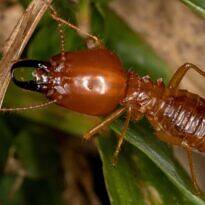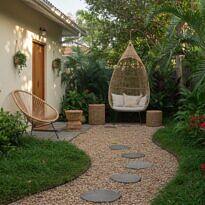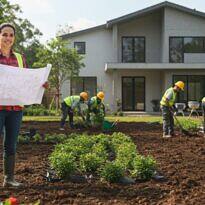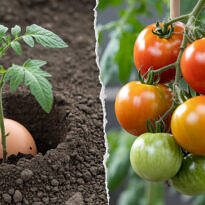Discover the ancient art of air layering, a method of vegetative propagation that dates back thousands of years. In this comprehensive guide, we’ll walk you through the step-by-step process of successfully air layering plants while providing essential tips and insights for a thriving outcome.

Air layering is one of the oldest methods of vegetative propagation. Historical evidence shows that the Chinese have been using it successfully for 4,000 years. Due to its less aggressive nature compared to cuttings, air layering is a recommended method for plants that struggle to root from cuttings and for those we wish to rejuvenate. Air layering is quite similar to ground layering, differing in that it doesn’t involve bending branches to the ground; instead, soil is brought up to the branch. Air layering can also be referred to as air rooting.

The method involves stimulating root growth on a branch or the main stem of a plant without separating it from the parent plant. This way, the developing branch continues to be nourished with sap, avoiding the dehydration and weakening that often occur with cuttings. On a larger scale, air layering is a more expensive and low-yielding method compared to cuttings. Therefore, it’s recommended primarily for plants that are difficult to propagate through other means.
Apart from being a propagation method, air layering is also an excellent way to rejuvenate overgrown plants with elongated and defoliated stems. This practice is common with Ficus, Dracaenas, Crotons, Mother-in-law’s Tongue, Philodendrons, and more.
There are two main methods of air layering. One is primarily for herbaceous and semi-woody branches and involves making a small transverse cut on the branch, keeping the cut open.
The other method, more suitable for woody branches, entails making two circular and parallel cuts and removing the bark in between, leaving a ring known as the Malpighian layer. The main difference between the methods is that the first one doesn’t interrupt the flow of elaborated sap, making it gentler, while the second one only allows the flow of raw sap, completely cutting off the passage of elaborated sap. Ringing can also be achieved by tying a metallic wire called a “noose” or “tourniquet.” An incomplete ring can also be made, leaving a small segment for the passage of elaborated sap.
After the cut, in either method, the next step is to wrap the area with damp moss, sphagnum, or another moist substrate, with or without rooting hormone applied to the cut area. Then, cover the substrate with preferably dark plastic, securing both ends with twine or adhesive tape without tightening. A small opening can be left at the top to allow for watering the substrate.
After a few weeks or months, depending on the species, the new roots will have formed, and the air-layered section can be cut just below the roots and replanted in a pot. At this stage, the roots are very delicate, so the small soil mass should be preserved when removing the plastic. After potting, the newly formed seedlings should remain in a humid greenhouse until fully rooted before transplanting to their final location.
Choosing the Right Time:
Begin by considering the timing of your air layering project. Typically, spring to early summer is the best period, as plants are actively growing, increasing the chances of successful root formation.
Essential Tools and Materials:
Gather the following tools and materials to ensure a smooth air layering process:
- Sharp pruning shears or scissors
- Plastic wrap (transparent or dark)
- Sphagnum moss or damp coco coir
- Rooting hormone (optional)
- Twine or adhesive tape for securing the plastic wrap
- An appropriate container or potting medium for the new plant
Step-by-Step Process:
- Selecting a Suitable Branch: Identify a healthy and vigorous branch that is about the thickness of a pencil. Younger branches tend to yield better results.
- Preparing the Branch: Depending on the branch’s maturity, either make a transverse cut or create two parallel circular cuts in the bark. For the latter method, remove the bark between the cuts, exposing the Malpighian layer—a critical step that encourages root development.
- Application of Rooting Hormone (Optional): If desired, apply rooting hormone to the exposed area. This hormone accelerates root growth and enhances the chances of successful rooting.
- Wrapping and Enclosing: Wrap the exposed area with damp sphagnum moss or coco coir, ensuring it remains consistently moist. Cover the wrapped section with plastic wrap and secure both ends, creating a humid microenvironment.
- Monitoring and Maintenance: Regularly check the moisture level of the moss or coir. Ensure that the plastic wrap remains intact and provides a conducive environment for root development. Shield the air layer from extreme temperatures and direct sunlight.
- Root Formation and Separation: After several weeks to months, depending on the plant species, roots will begin to form. Once they reach a length of approximately 5 to 10 cm, carefully cut below the newly formed roots. Pot the air-layered section in an appropriate container, using a suitable potting mix.
Post-Air Layering Care:
Place the potted plant in a protected area to facilitate root establishment. Water the plant adequately, keeping the soil consistently moist but not waterlogged. Gradually acclimate the plant to outdoor conditions before transplanting it to its final location.
Species-Specific Tips:
While the general process remains consistent, different plant species may have unique requirements that contribute to their successful root formation. In this article, we’ll delve into the world of species-specific tips in air layering, exploring how to tailor this technique to different plants for optimal results.
Understanding Plant Diversity: Plants vary widely in their growth habits, root systems, and overall biology. This diversity necessitates adapting air layering techniques to accommodate the specific needs of each plant. By understanding the distinct characteristics of the plant you’re working with, you can significantly enhance your success rate.
Leafy and Woody Species: Leafy plants, such as philodendrons and monstera, often respond well to air layering. To maximize your chances of success, focus on providing consistent moisture and humidity. For woody species like magnolias and fruit trees, the emphasis should be on creating a proper wound for root initiation. Ensure that the exposed area is adequately treated with rooting hormone to stimulate root growth.
Understanding Growth Patterns: Consider the natural growth patterns of the plant when choosing the location for air layering. If a particular species tends to produce aerial roots along its stems, targeting those areas can increase the likelihood of root formation. This is common in plants like the Ficus genus.
Timing Matters: Timing plays a crucial role in air layering success. Research the growth cycle of the specific plant and choose the most suitable season for air layering. For deciduous trees, targeting the period just before the active growth season begins can yield better results, as the plant’s energy is focused on root development.
Special Care for Fruit Trees: Fruit-bearing trees, such as apple or citrus trees, can benefit from air layering to produce clones of desirable cultivars. To ensure success, focus on providing consistent moisture to the air layer and maintaining a stable microclimate. Keeping the plastic wrap in place and monitoring the development of roots is essential.
Vining and Climbing Plants: Plants with vining or climbing tendencies, like grapes or wisteria, often have nodes along their stems where aerial roots can emerge. Targeting these nodes for air layering can lead to quicker root development. Additionally, these plants may benefit from a slightly looser plastic wrap to accommodate their growth.
Pruning and Shape Management: For plants that have grown too tall or lack foliage along their lower portions, air layering can serve the dual purpose of propagation and shape management. In such cases, focus on creating air layers in areas that require rejuvenation. Prune the upper portions of the plant to promote branching and a more compact shape.
Fragile Plants and Delicate Roots: Some plants have delicate root systems that require extra care during the air layering process. Orchids and ferns fall into this category. Use a gentle touch when wrapping the exposed area, and consider using a clear plastic wrap to monitor root growth without disturbing the delicate roots.
Trial and Error: It’s important to acknowledge that not all air layering attempts will be successful, especially when dealing with specific species. Be prepared for some trial and error, and don’t be discouraged by initial failures. Each experience provides valuable insights for refining your technique.
Tailoring Success for Every Plant: In the realm of air layering, there’s no one-size-fits-all approach. Recognizing the unique characteristics of different plant species and adapting your technique accordingly is the key to achieving consistent success. Whether you’re working with leafy greens, woody trees, or delicate ferns, taking the time to understand each plant’s needs will unlock the true potential of air layering as a propagation method.

Common Challenges and Solutions:
Be prepared for challenges such as fungal infections, pest issues, or unsuccessful rooting.
1. Challenge: Slow or No Root Formation: One of the most frustrating challenges in air layering is when roots develop too slowly or not at all. This can be attributed to factors such as insufficient moisture, incorrect timing, or suboptimal environmental conditions.
Solution: Enhance Moisture and Environmental Conditions:
- Ensure the moss or coco coir remains consistently moist throughout the process.
- Opt for the right timing—spring to early summer when plants are in their active growth phase.
- Shield the air layer from extreme temperatures and direct sunlight, as both can impede root development.
2. Challenge: Fungal Infections: Fungal infections can attack the moist environment created around the air layer, jeopardizing root growth and overall success.
Solution: Maintain Proper Hygiene and Ventilation:
- Use sterilized tools to make cuts and handle the air layer.
- Apply a fungicide or antibacterial solution to the moss or coir before wrapping.
- Allow for some ventilation by not sealing the plastic wrap too tightly, preventing excess humidity that encourages fungal growth.
3. Challenge: Inadequate Rooting Hormone Response: Sometimes, even with the application of rooting hormone, the roots fail to develop as anticipated.
Solution: Optimize Rooting Hormone Application:
- Ensure the rooting hormone is fresh and within its expiration date.
- Apply the hormone generously to the exposed area, as it aids in encouraging root growth.
4. Challenge: Premature Leaf Drop: During the air layering process, the plant may drop leaves prematurely due to stress.
Solution: Maintain Consistent Care:
- Minimize stress by carefully handling the plant during the process.
- Avoid unnecessary disturbances to the air layer, such as strong winds or excessive movement.
5. Challenge: Unsuccessful Separation of Air Layer: When it’s time to cut and separate the air layer from the parent plant, difficulties might arise.
Solution: Precise Cutting Technique:
- Use sharp, clean pruning shears to ensure a clean cut.
- Make the cut just below the newly formed roots to avoid damage.
- Pot the air-layered section immediately in an appropriate substrate to prevent root desiccation.
6. Challenge: Lack of Progress Monitoring: Neglecting to monitor the progress of the air layering process can lead to missed opportunities or unnecessary complications.
Solution: Regular Inspection and Adaptation:
- Regularly check the moisture level of the moss or coir.
- Monitor root development by gently lifting the plastic wrap and assessing growth.
Air layering, while rewarding, does present its fair share of challenges. However, armed with knowledge and proactive solutions, you can navigate these hurdles and achieve successful propagation outcomes. By addressing issues such as slow root formation, fungal infections, hormone response, and more, you’ll be well on your way to mastering this ancient technique for expanding your garden with healthy, thriving plants.
Beyond Propagation:
Apart from propagation, air layering can rejuvenate overgrown plants, improve their form, and yield identical copies of desirable plants.
Safety First:
Exercise caution when using sharp tools and chemicals such as rooting hormone. Follow safety guidelines to prevent accidents.
Plants Recommended for Air Layering:

- Azalea
- Maples (Acer sp)
- Cherry tree
- Cypress
- Surinam cherry tree
- Pomegranate
- Jabuticaba tree
- Holly
- Camellia
- Orange tree
- Apple tree
- Pecan tree
- Pear tree
- Gardenia
- Magnolia
- Rosebush
- Dracaenas
- Mother-in-law’s Tongue
- Ficus
- Philodendron
- Monstera
- Croton
- False aralia
- Thuja
- Pine trees
Master the art of air layering and unlock the potential of multiplying your favorite plants while rejuvenating those that have outgrown their space. By following these comprehensive steps and insights, you’ll achieve successful air layering results that will enhance your gardening endeavors.






